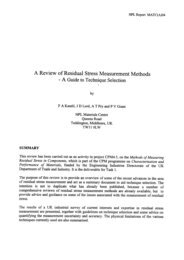Dimensional Measurement using Vision Systems - NPL Publications ...
Dimensional Measurement using Vision Systems - NPL Publications ...
Dimensional Measurement using Vision Systems - NPL Publications ...
You also want an ePaper? Increase the reach of your titles
YUMPU automatically turns print PDFs into web optimized ePapers that Google loves.
<strong>Measurement</strong> Good Practice Guide No. 39<br />
with the scale oriented on the Y-axis, to check the squareness of the calibration, as the<br />
camera may not have square pixels. Failure to account for this may introduce significant<br />
errors into the measurements. Most systems can produce a software - generated grid. If<br />
this grid is superimposed on the image of the graticule grid, any large-scale image<br />
distortions will become evident.<br />
7.4 SETTING THE CORRECT DETECTION THRESHOLD<br />
After calibrating the system, detecting objects will require setting a threshold. A vision<br />
system performs measurements by detecting changes in intensity and hence, the contrast<br />
of a feature e.g. a black spot against a white background. As each pixel has an 8-bit grey<br />
scale intensity value range, 0 being black and 255 white, the user can define a threshold on<br />
the grey scale so that regions with intensity above or below that value can be detected. In<br />
this way, a binary image is created, whereby pixels with a greyscale intensity value below<br />
the threshold are assigned a binary 0, and those above, a binary 1. Depending on whether<br />
bright or dark features are to be measured, adjacent detected pixels are grouped together<br />
to form a detected feature. Modern vision systems may have the facility to perform grey<br />
image processing of features, but for the purposes of this guide, only binary image<br />
processing will be covered. Figure 28 shows a typical intensity profile of a dark feature on<br />
a bright background. The maximum intensity range of the camera is 0-255 greyscale, but<br />
the actual dynamic range of the image may well be less, especially if there is low contrast.<br />
The correct threshold level should be calculated from the image grey scale range. This is<br />
called normalising the intensity threshold. For most vision systems, where the optical<br />
magnification is less than 20x, the 50% normalised threshold should be used. The effects of<br />
coherence from the illumination on the true edge position of a feature can be neglected at<br />
this scale, as it is well below the measurement uncertainty achievable. The formula for<br />
calculating the 50% threshold is given in equation 14:<br />
t = b + (a – b)/2<br />
…..(14)<br />
Where ;<br />
t = Grey scale intensity threshold<br />
b = Mean dark level intensity<br />
a = Mean bright level intensity<br />
50
















